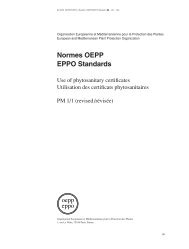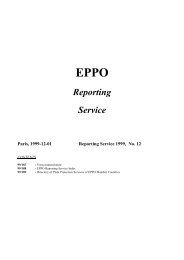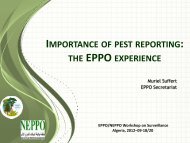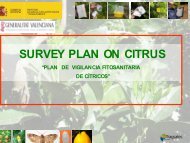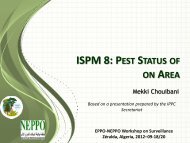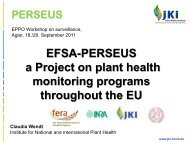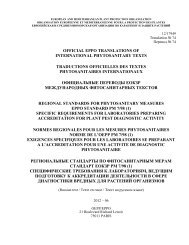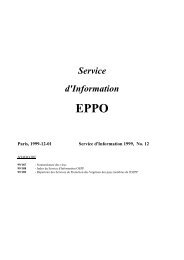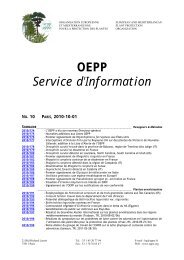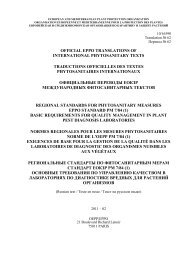EPPO Reporting Service - Lists of EPPO Standards - European and ...
EPPO Reporting Service - Lists of EPPO Standards - European and ...
EPPO Reporting Service - Lists of EPPO Standards - European and ...
You also want an ePaper? Increase the reach of your titles
YUMPU automatically turns print PDFs into web optimized ePapers that Google loves.
<strong>EPPO</strong> <strong>Reporting</strong> <strong>Service</strong> – Pests & Diseases<br />
2010/015 Hypercompe icasia intercepted on pot plants in the Netherl<strong>and</strong>s<br />
The NPPO <strong>of</strong> the Netherl<strong>and</strong>s informed the <strong>EPPO</strong> Secretariat <strong>of</strong> the interception <strong>of</strong><br />
Hypercompe icasia (Lepidoptera: Arctiidae). Insect larvae were found on Dracaena pot<br />
plants imported from Costa Rica in 2009. This species had been intercepted before on<br />
Begonia pot plants imported from Costa Rica in 2006 (eggs) <strong>and</strong> in 2008 (larvae). H. icasia<br />
is a polyphagous pest (e.g. Apium, Citrus, Musa, Phaseolus, cultivated Solanaceae, Vanilla)<br />
which is known to occur in South America, Central America, <strong>and</strong> the Caribbean. In its<br />
current area <strong>of</strong> distribution, the incidence <strong>of</strong> the pest is generally low <strong>and</strong> no severe<br />
outbreaks have been reported.<br />
Pictures <strong>of</strong> the adults can be viewed on the Internet:<br />
http://www.inra.fr/papillon/arctiid/texteng/h_icasia.htm<br />
Source: NPPO <strong>of</strong> the Netherl<strong>and</strong>s, 2009-06.<br />
Additional key words: interception Computer codes: NL<br />
2010/016 First record <strong>of</strong> Monilinia fructicola in Germany<br />
The NPPO <strong>of</strong> Germany recently informed the <strong>EPPO</strong> Secretariat <strong>of</strong> the first record <strong>of</strong><br />
Monilinia fructicola (<strong>EPPO</strong> A2 List) on its territory. The fungus has been detected in an<br />
orchard in fruits <strong>of</strong> Rubus fruticosus (blackberries) <strong>and</strong> in an adjacent orchard in fruits <strong>of</strong><br />
Prunus domestica (plums). Symptoms were first observed on 2009-08-01, but the<br />
identification <strong>of</strong> the pathogen by PCR was completed only on the 2009-11-19. The origin <strong>of</strong><br />
this infestation remains unknown. Eradication measures have been applied <strong>and</strong> intensive<br />
surveys are being carried out in the area where the fungus was detected.<br />
The pest status <strong>of</strong> Monilinia fructicola in Germany is <strong>of</strong>ficially declared as: Transient,<br />
actionable, under eradication.<br />
Source: NPPO <strong>of</strong> Germany, 2009-12.<br />
Additional key words: new record Computer codes: MONIFC, DE<br />
2010/017 Blueberry scorch virus detected in Trentino-Alto Adige <strong>and</strong> Piemonte<br />
regions, Italy<br />
In 2004, the presence <strong>of</strong> Blueberry scorch virus (Carlavirus, BlScV – <strong>EPPO</strong> A2 List) was<br />
reported for the first time in Europe. BlScV was detected in a small number <strong>of</strong> Vaccinium<br />
corymbosum plants cultivated in Piemonte region, Italy (<strong>EPPO</strong> RS 2005/101). In 2009, the<br />
NPPO <strong>of</strong> Italy again reported the presence <strong>of</strong> BlScV in Piemonte (4 outbreaks) <strong>and</strong> in a new<br />
area in the region <strong>of</strong> Trentino-Alto Adige (1 outbreak).<br />
Trentino-Alto Adige<br />
The Regional PPO <strong>of</strong> the region <strong>of</strong> Trentino-Alto Adige detected the presence <strong>of</strong> BlScV in<br />
the municipality <strong>of</strong> Carzano (Bassa Valsugana e Tesino, province <strong>of</strong> Trento). The virus was<br />
detected in a glasshouse (1700 m²) on 2 plants only (1 Vaccinium corymbosum <strong>and</strong> 1 V.<br />
ashei). The 2 infected plants were destroyed. Surveys were initiated in the surroundings to<br />
determine the extent <strong>of</strong> the disease. Seven production sites <strong>and</strong> 3 nurseries producing<br />
17




